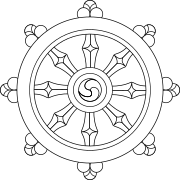Dharmacakra

| Bagian dari seri tentang |
| Buddhisme |
|---|
 |
|
Dharmacakra (dari bahasa Sanskerta), Dhammacakka (bahasa Pali), Roda Dharma, atau Roda Dhamma adalah simbol yang umum digunakan secara luas oleh Buddhisme.[1][2] Simbol ini juga digunakan dalam agama Hindu, khususnya di tempat-tempat yang mengalami transformasi agama,[3][4][5][6] Jainisme, dan di India modern.
Secara historis, dharmacakra sering digunakan sebagai hiasan patung dan prasasti di Asia Timur.[7] Dharmacakra tetap menjadi simbol utama Buddhisme hingga saat ini.
Delapan ruas pada Dharmacakra melambangkan Jalan Mulia Berunsur Delapan (Pāli: ariya aṭṭhaṅgika magga), ajaran utama Buddha Gautama tentang jalan yang menuntun kepada Nibbāna, sejak zaman Buddhisme awal. Dharmacakra dihubungkan dengan peristiwa pemutaran Roda Dharma pertama kali oleh Buddha di Taman Rusa Isipatana. Dharmacakra mengajarkan bahwa kebenaran itu seperti lingkaran atau roda dari sebab dan akibat. Artinya, sebab yang satu timbul dari sebab yang lainnya. Hukum sebab-akibat yang saling bergantungan ini disebut sebagai Dependensi Kemunculan (Pāli: paticcasamuppada).[8] Dharmacakra juga melambangkan Empat Kebenaran Mulia (Pāli: cattāri ariyasaccāni), yaitu hidup adalah penderitaan, penderitaan berasal dari suatu sebab, sebab penderitaan dapat dimusnahkan, ada jalan untuk melenyapkan sebab-sebab penderitaan.[9]
Rujukan
[sunting | sunting sumber]- ^ John C. Huntington, Dina Bangdel, The Circle of Bliss: Buddhist Meditational Art, p. 524.
- ^ "Buddhist Symbols". Ancient-symbols.com. Diakses tanggal 22 June 2018.
- ^ Mansinha, Mayadhar (10 September 2021) [1960]. "CHAPTER VIII. THE POST SARALA PERIOD - A PERIOD OF EXPERIMENTS: I.The Buddhist Influence - The Metaphysical Poets". History of Oriya Literature. Creative Media Partners, LLC. ISBN 978-1015025486.
- ^ Nayak, Dr. Ganeswar (11 March 2014). "History of Odisha (From earliest times to 1434 A.D)" (PDF). Paralakhemundi: Shri Krushna Chandra Gajapati Autonomous College. hlm. 107.
- ^ Misra, Bijoy M. (2007). Bryant, Edwin Francis, ed. Krishna: A Sourcebook. Oxford University Press. hlm. 141. ISBN 978-0195148923.
- ^ Sahu, Nabin Kumar (1958). "Sailodbhavas, Bhaumakaras and Somavamśīs,". Buddhism in Orissa. Bhubaneshwar: Utkal University. hlm. x. OCLC 1391872675.
- ^ "Dharma And Ethics The Indian Ideal Of Human Perfection 1st Published". priscilla.work (dalam bahasa Inggris). Diarsipkan dari versi asli tanggal 29 October 2021. Diakses tanggal 2021-10-29.
- ^ Anonym (1989). Ensiklopedi Nasional Indonesia. Jakarta: Cipta Adi Pusaka.
- ^ Hassan Sadhily. Ensiklopedi Indonesia. Jakarta: Ichtiar Baru-Van Hoeve. hlm. 807.
Text is available under the CC BY-SA 4.0 license; additional terms may apply.
Images, videos and audio are available under their respective licenses.
